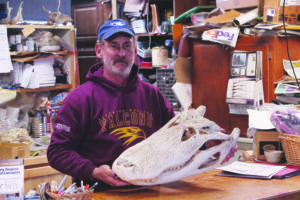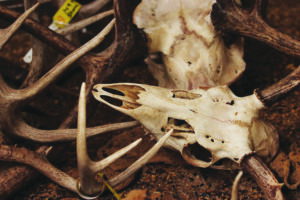
by John Dowd
When it comes to hunting, stories and tales around the fireplace can only go so far. To relive the adventure, many hunters strive to preserve some piece of that excitement. Of all the ways, there is really only one that can recapture the moment: mounting. Of all the ways to do this, one of the oldest and most affordable is the European mount. Many of these very old skeletal and crowned beasts live on today, preserved well past their executioners. Though a very old method for creating mounts and done through multiple means, most today are created through a chemical process. However, a champion of an older means still works out of his garage in Ravalli County, just north of Stevensville. His name is Gary Haas.
Haas brings with him a series of fantastic life tales available to anyone that will listen, all of which led him to the profession of creating European mounts through the harnessed power of beetles. To understand this journey, one has to look back at a life lived for the love and preservation of the natural world. Haas started work with Montana State University (MSU) in the wildlife prep room, under the supervision of Philip Wright, while he was going to school for a wildlife biology degree. After that, he would go on a several year adventure that would change his life.

Haas joined the U.S. Peace Corps, and found his way to St. Vincent and the Grenadines in the late 80’s and early 90’s. The series of islands in the Caribbean would become a proving ground of adventure for the young biologist. During his time there he would act as a wildlife environmental specialist, natural resource developer and provide environmental education. He would go on to write a review on the environmental problems of 23 islands, 16 of which he was physically on. He would write many other works while down there, including a book on the St. Vincent parrot, which is an endangered species endemic only to the main island.
During his 26 months on the islands, Haas found and lost love, was ridiculed for being white among fiercely religious and superstitious black slave descendant locals, stranded on desert islands for days, chased and swatted by little old local women with brooms made from mistletoe to drive dark spirits from him, the discoverer of scientifically unrecognized species and much more.
Upon returning to the states, Haas found that the department from which he graduated had seen several break ins to the animal behavior laboratories. The situation had grown so bad that the beetle colony, established in 1980 by Wright, had been moved off campus. That colony was responsible for the numerous skeletal museum quality exhibits and presentations at the school. The beetles were used to clean the bones of dead animals to allow them to be studied with high levels of accuracy, and minimal warpage or shrinkage. Haas bought the colony after the program was going bankrupt, and started working in Missoula, carrying on the work for hunters. He eventually moved twice more, ending up in his present location in 2006.
Fortunately, Haas informs that he lost his sense of taste and smell some time ago. Haas says, “People tell me, ‘I guess you’re in the right line of work.’” His wife, however, hates the smell. “She makes me strip down before I go back inside the house,” said Haas.
Haas’s colony originated in Africa. However, they have now had a local Montana variety mixed into the gene pool, which are a hardier sort. His over 10 million beetles can clean a deer skull in just under two days if it is alone in a tray. Haas will do up to 60 skulls at a time. Most are completely flesh free after almost a week. In the wild, the beetles would have a life cycle of over 10 months. Haas explains that he doesn’t believe his beetles ever make it more than four. “They literally just burn out,” said Haas.
Trying to expand, Haas has been attempting to build a new building on his property for over 16 years. Under normal circumstances it may not have taken so long, but his beetles are a force to be reckoned with. They can, and will, devour more than just dead flesh. His two-centimeter-long beetles and larvae will eat through most traditional construction materials in short order. The only things he has found to be resistant are stainless steel, concrete and fiberglass. The relentless insects have a fondness for drywall and can find their way through most cracks and crevices. Their dung is also high in ammonia and can even corrode stainless steel. Trying to explain the sheer force of nature of these beetles has made finding a contractor to stick with the project very difficult. On top of that, funding is limited and often has a short window. Aligning all these aspects has made expanding difficult.

Another issue threatening his business has been the spread of Chronic Wasting Disease (CWD) among ungulate populations. The Montana Fish, Wildlife and Parks has threatened to shut him down several times. However, he has stayed on top of the very limited CWD research there is, to ensure none of his processes aid in the spread of the disease. He even used to make compost with his beetle dung, but now packages it and sends it to the local biohazard-level dump. His new building will have to take special precautions into consideration for this as well. A room to house these beetles would need to have good climate control as well, because they are very sensitive to the cold. Despite these hurdles, Haas expects to get a new building started this spring and plans to do much of the work himself.
Before even placing a skull into the beetle room, Haas has his customers, located in 43 states, do a lot of the preprocessing, including eye and brain removal as these are toxic to the beetles. This helps mitigate any CWD spread. After finishing a skull through the beetles, Haas will degrease them and put them through a hydrogen peroxide bath to whiten them.
After facing beetle die backs, strange beetle drops in activity, funding concerns, trying to keep his prices low, problems in settling construction and much more, Haas still strives to keep his business going. “I told myself I would do it, and I will,” said Haas, who would love to see one of his sons take over the business one day. His dream is for it to really take off and fund the rest of his life, as well as pay for his kids’ school. “My parents did that for me and I would like to do it for my boys, too.”
When asked why he does what he does, dealing with the smell, the bugs and the rotting carcasses, Haas explained, “It’s all about preserving the memories of a young person’s first hunt. I have had many people say they were so happy they were able to preserve their son’s or daughter’s first hunt, and that makes it all worthwhile. Unfortunately, we are losing more hunters than we are gaining. Mainly through the loss of access to public lands.” He went on to talk about numerous issues that are detrimental to the continuation of hunting culture. Haas does all he can to help keep it alive and show respect to those who helped earn him that right. For wounded warriors, he will clean anything for $5. For any active or retired military, he will give 20% off.
Haas is the owner of Big Sky Beetle Works, located at 5189 Hwy 93S, Florence. He can be reached on his phone at (406) 777-3638, or by email at beetleman@montana.com.